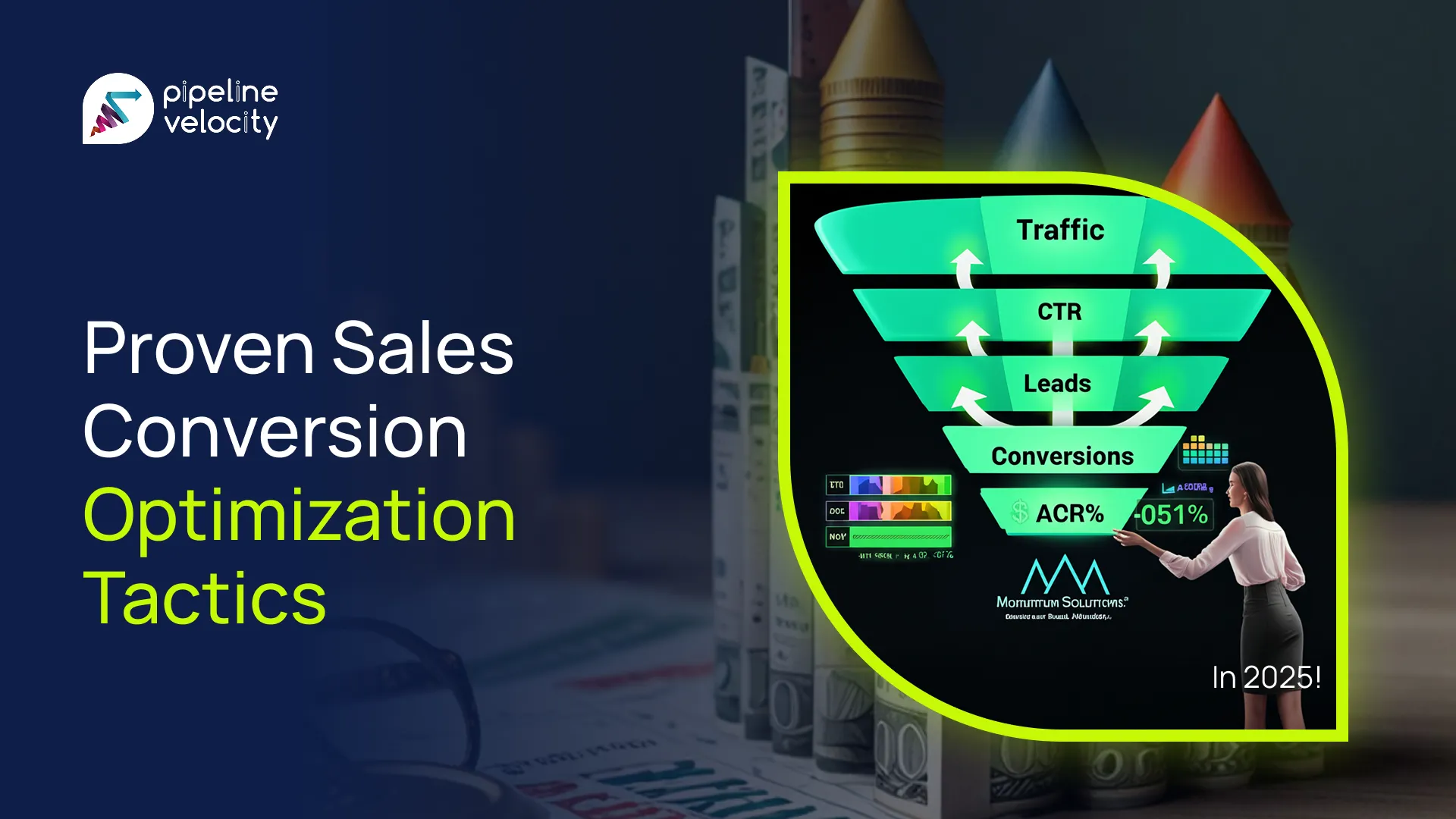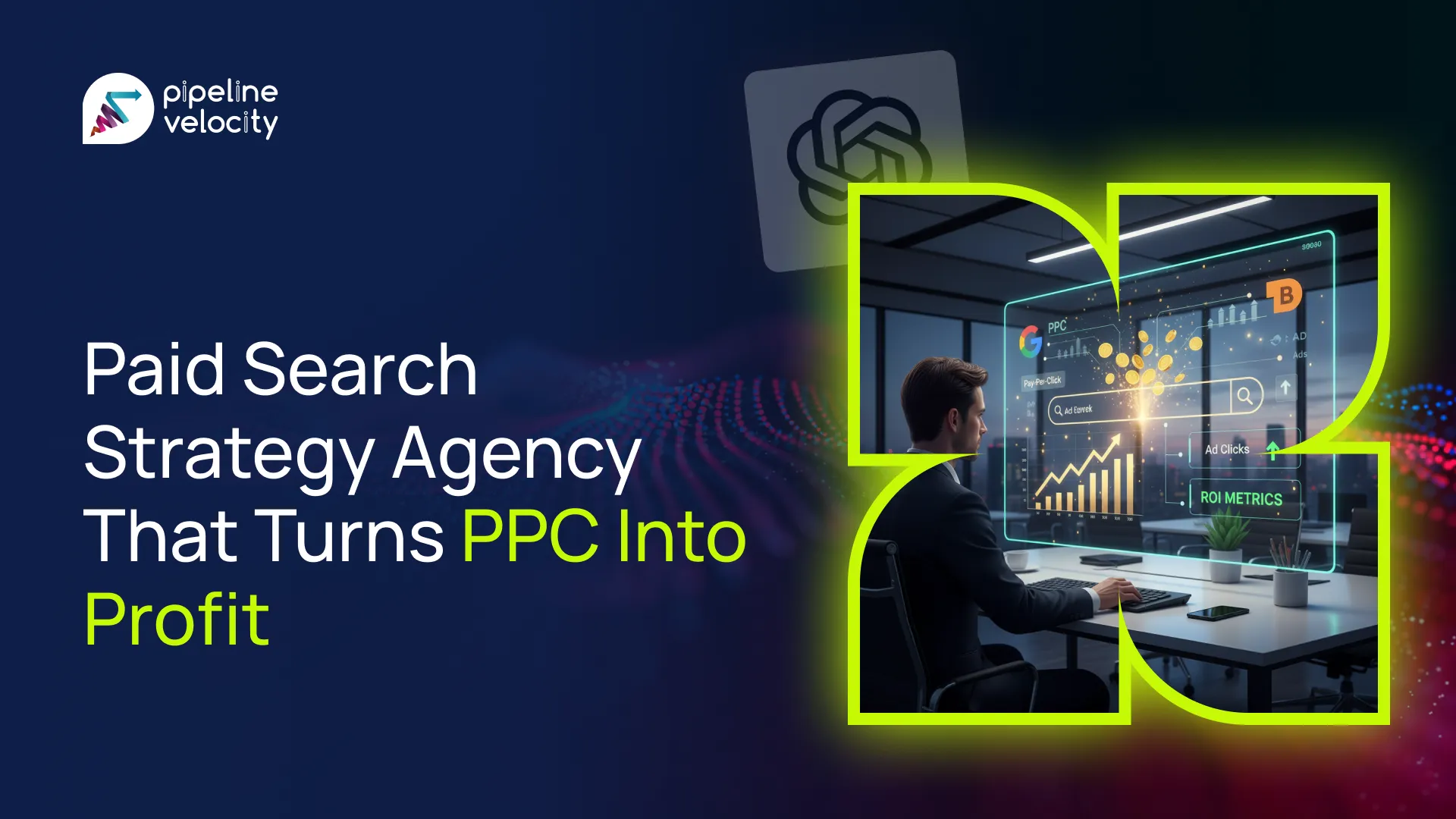Growth marketing wins revenue when you need full-funnel lift, faster test cycles, and stronger customer lifetime value. Digital marketing delivers reach and leads with proven channels like search, social and email. Growth marketers own the funnel end to end and use tight experiments to raise conversion rates at every step. Digital marketers excel at channel execution, brand lift and cost-efficient acquisition at scale. Companies that combine both models usually cut CAC, raise retention and improve payback periods. Mid-market firms often start with digital marketing to build demand, then layer growth to improve conversion and expansion. Early-stage teams lean on growth to find product market fit while using digital marketing for predictable pipeline. Keep reading for clear differences, practical choices and examples you can copy this quarter.
Growth Marketing vs Digital Marketing: What Is the Difference
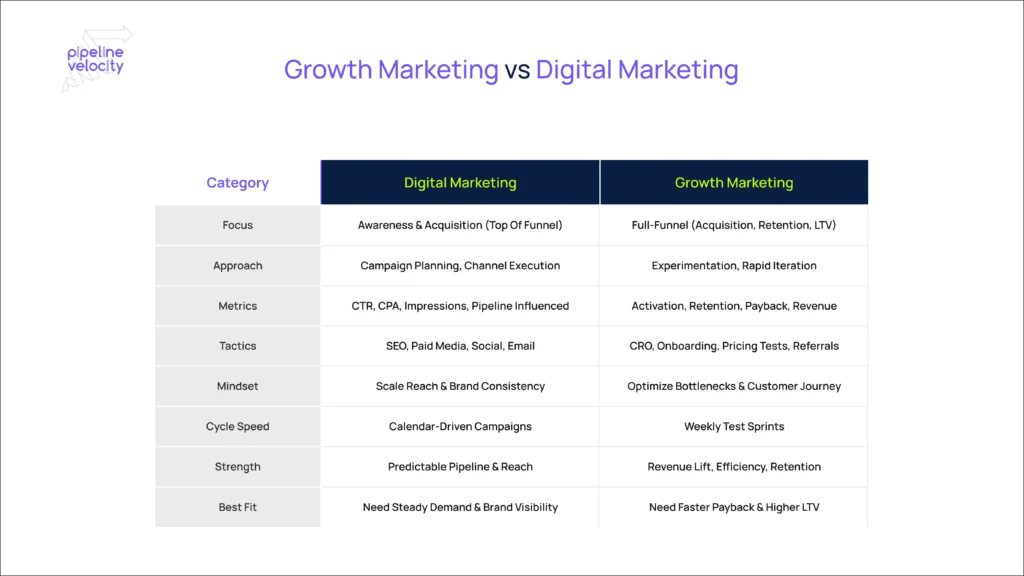
This section sets the record straight on definitions so your team speaks the same language and can pick the right playbook. Growth marketing is a full-funnel practice that blends product, data and marketing to drive revenue outcomes such as activation, retention and expansion. Digital marketing focuses on channel execution across search, social, content, email and paid media to generate awareness and demand. Growth teams measure success on revenue, LTV, payback and cross-sell, not just clicks or leads. Digital teams report on impressions, CTR, CPA and pipeline influenced, which still matters when you scale reach. The smartest companies set clear swim lanes, then connect both groups with shared goals and integrated dashboards.
Key differences in strategy and execution
You need clear contrasts to avoid duplicate work and missed targets, so this section clarifies how each model operates. Growth marketing starts with hypotheses, runs rapid experiments and adjusts product and messaging based on real behavior. Digital marketing creates planned campaigns, schedules content calendars and optimizes channels for cost and reach. Growth cares about velocity of learning and moves resources to the next highest lift across the funnel. Digital cares about reliable delivery, brand consistency and efficient media spend. When you align planning, growth supplies insights from experiments while digital scales what works through mature channels.
How growth marketers think differently than digital marketers
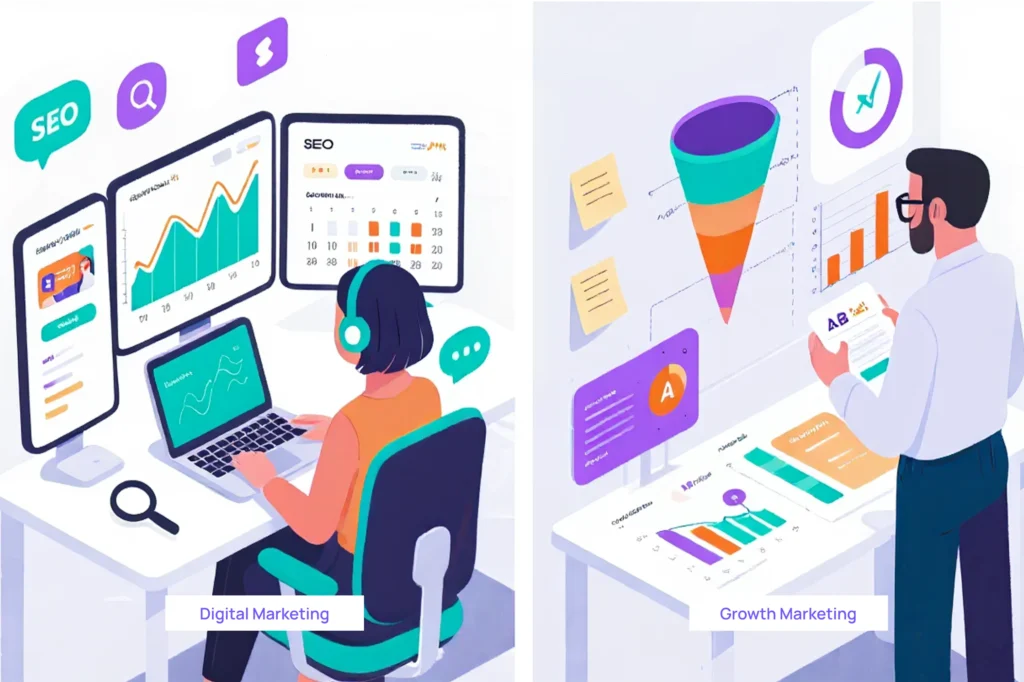
Mindsets shape outcomes, and this section explains how growth pros approach problems compared to channel specialists. Growth marketers obsess over the full customer journey from impression to renewal and referral. They ask why users drop at activation, which message moves expansion, and how pricing or onboarding affects churn. Digital marketers ask which keywords drive quality leads, which audiences convert, and which creatives improve CTR. Growth teams prefer small, controlled tests and ship improvements weekly. Digital teams prefer calendar discipline and brand guidelines that build trust over time. Pairing these mindsets gives you both speed and scale without chaos.
The role of brand awareness vs customer acquisition
Brand and acquisition both matter, so this section shows where each method shines and how to avoid false trade-offs. Digital marketing drives brand awareness with consistent reach across search, social and display while feeding the top of the funnel. Growth marketing converts that demand by improving landing pages, onboarding, pricing and product prompts. A strong brand lowers acquisition costs and improves conversion rates because people trust you before they click. A strong growth engine turns more of that demand into revenue and keeps customers around longer. Treat brand as a compounding asset and growth as the engine that monetizes it.
Pipeline Velocity: Services to Drive Measurable Growth
Our services at Pipeline Velocity focus on the moves that raise revenue fast without wasting spend. We build full-funnel systems through our Growth Marketing Services and tighten conversion with focused SEO Services. When you need demand quickly, our PPC Management and Social Media Marketing programs drive qualified traffic that sales can close. We ship experiments weekly, report on revenue metrics that matter and hand your team a clear next step after every sprint. If you want help prioritizing the next high-ROI lever, we scope a plan that fits your budget and timeline.
Components of Digital Marketing
You want a clear inventory of digital parts, so this section breaks down the core elements that power reach and demand. Digital marketing includes search engine optimization, paid search, paid social, display, programmatic, content marketing, email, and marketing automation. It also includes analytics platforms, attribution modeling and creative production that feeds every channel. Strong digital teams maintain brand standards, build content libraries and manage budgets across campaigns and audiences. They optimize based on CPA, ROAS and share of voice to drive predictable pipeline. With the right brief and tracking, digital becomes the engine that feeds sales every month.
For deeper context on how content still drives traffic, see our explainer on Are Blogs Still Relevant in 2025? and the practical guide to Optimizing Blogs for Generative Engines.
Core digital marketing channels businesses rely on
Channels make or break the plan, and this section maps the ones that most businesses scale first. Search delivers high-intent traffic when prospects compare options or seek solutions. Paid social expands reach to qualified audiences with creative that educates, entertains and converts. Display and programmatic build frequency and keep offers visible across the web. Content marketing powers search rankings, nurtures prospects and equips sales with assets for follow-ups. Email and marketing automation convert interest into meetings with timely sequences, offers and triggers.
Role of search engine optimization and paid media
Search and paid media carry a large share of budget, so this section shows how to get more from both. Search engine optimization compounds over time by earning rankings on keywords that signal problem, solution and brand intent. You raise authority with technical fixes, helpful content and relevant internal links that guide readers. Paid search captures immediate demand and fills gaps while SEO matures. Paid social and display test messages, hook new audiences and retarget visitors who need more proof. You track incremental lift, not just last-click results, and you tune bids, keywords and creatives every week.
For proof that SEO still works alongside AI search, review our take on Does SEO Still Work in 2025? and how to balance SEO vs GEO in 2025. To scale paid results while organic matures, consider purpose-built Paid Ads Programs.
Social media marketing and content marketing tactics
You need practical tactics, so this section highlights moves that work across budgets and industries. Build pillar content that answers buyer questions and splice it into short posts, carousels and video clips. Use social proof in captions, including outcomes, ratings and brief quotes that build trust. Post native content that fits the platform culture, then retarget engagers with offers. Create content that maps to each stage of the funnel, from problem explainers to ROI breakdowns. Repurpose webinars into blog posts, checklists and email sequences to keep content working long after the live event.
Win attention with creativity rooted in buyer insight, not gimmicks. Tie each post to a clear outcome so your team can see cause and effect without guesswork.
Follow the FTC Endorsement Guides when you work with creators so disclosures stay clear and compliant.
Email marketing and traditional marketing efforts
Email and traditional channels still convert, so this section explains how to use them without waste. Email works when you segment by behavior, keep subject lines clear and send value before asks. Use triggered flows for welcome, post-demo follow-ups, win-back and expansion nudges. Direct mail, events and sponsorships still drive pipeline when they tie back to digital tracking and strong offers. PR builds authority and interest that lowers CAC on paid channels. Phone outreach supports all of it when reps reference content and tailor the ask to the buyer’s last action.
Collect the right email address at each step and confirm it with a quick check to keep deliverability high. Send helpful product updates and release notes as short briefs that point people to value, not long blasts that bury the ask.
Components of Growth Marketing
Growth has its own toolkit, and this section outlines what you need to run experiments and scale wins. Growth marketing blends analytics, CRO, product prompts, lifecycle messaging and pricing tests. It uses event tracking, cohort analysis and funnels to find the biggest drop-offs. Growth teams own onboarding, referral loops and paywall or plan logic that affects conversion. They run short sprints with clear hypotheses, sample sizes and success thresholds. They document learnings so digital, product and sales can scale what works.
Growth stays customer-centric by mapping friction from the user’s view before anyone edits copy or code. Teams talk to customers weekly and turn those notes into specific tests that reduce effort and raise time to value.
Data-driven decisions and growth hacking techniques
You want rigor, not hunches, so this section shows how growth teams decide their next move. They set a single north-star metric like activation rate, time to value or expansion revenue. They build a backlog of experiments that target the largest bottlenecks, not random ideas. They use event data to segment users by behavior and tailor experiences to each group. Growth hacking techniques include onboarding nudges, referral rewards, in-product education and value-based pricing tests. Each test ships fast, runs on clear timelines and drives a decision to roll out, revise or retire.
A/B testing and performance marketing focus
Testing keeps opinions from draining budget, so this section explains how to test right. A/B tests need one variable at a time, clean randomization and a pre-set sample size to avoid noise. Growth teams choose metrics that matter such as activation, conversion and revenue per user. They also keep a backlog of follow-up tests so they keep learning even when a result is flat. Performance marketing supports this with creative, offers and landing pages designed for rapid iteration. Together you get faster wins, less waste and a roadmap that keeps improving outcomes.
Customer acquisition and customer retention strategies
Winning the first purchase does not pay the bills alone, so this section covers both sides of revenue. Acquisition moves include intent-driven SEO, paid search on bottom-funnel terms, and direct response offers on social. Retention moves include better onboarding, helpful lifecycle emails, loyalty rewards and product education that raises usage. Expansion moves include cross-sell prompts, value-based bundles and time-bound upgrades that showcase benefits. Referral loops turn happy customers into distribution by rewarding shares and mentions. When you improve retention, every paid channel gets more efficient because lifetime value rises.
Growth marketing services offered by agencies
If you plan to hire help, this section clarifies what growth-focused partners usually deliver. Services include analytics setup, customer data repository maintainence, funnel mapping, CRO audits and experiment design. Agencies build landing pages, run onboarding tests, design pricing experiments and implement lifecycle messaging. Some can even offer referral marketing. They coach teams on hypothesis writing, sample size planning and test analysis. Many also pair with engineering to add event tracking and in-product prompts. The right partner shows revenue impact with clear before and after metrics, not vanity charts.
How to Choose the Right One for Your Company
You want a choice you can defend, so this section gives a clear path based on your current stage. Start with your bottleneck. If no one knows you, digital marketing that builds demand may be the right first step. If you get traffic and trials but revenue lags, growth marketing likely pays off faster. Consider budget, timelines and internal skills because both models need focus to work. Match the agency’s strength to your biggest gap and set shared goals your CFO cares about.
Use market data when you size opportunity. The U.S. Census Bureau’s Business Dynamics Statistics offers free trend data that informs channel and budget choices by industry and firm size.
When you compare vendors, ask for stage-by-stage impact, not a generic package list. Good partners show how their work lifts rankings, conversion or retention with timelines and owner names.
Factors to consider based on your business growth goals
Goals drive the plan, so this section maps typical objectives to the right approach. If you need brand lift and more top-of-funnel awareness, invest in content, SEO and paid reach. If you need higher conversion to hit revenue targets without more spend, invest in CRO, onboarding and pricing tests. If you need faster payback, shift mix toward high-intent search and landing page improvements. If you need stronger LTV, build retention, expansion and referral programs. Align measurement to these goals so you know which bets to double down on each quarter. It is although important to understand the intense growth marketing experimentation phase. This is how advertisers know what works for you and what doesn’t.
When a digital marketing agency is the better fit
Sometimes channels are the choke point, and this section calls out the signs you need channel power first. Your site has thin content, slow pages and weak rankings on important terms. Your paid accounts lack structure, clear audiences or creative variety, which caps reach and raises CPA. Your social presence lacks consistent posting, community engagement or clear offers. Your analytics show big gaps like untagged links or missing conversions. A strong digital marketing agency fixes these issues fast and gives your team a steady flow of qualified traffic.
When a growth marketing agency drives stronger results
Sometimes conversion is the choke point, and this section helps you spot that scenario. You get traffic but trial-to-paid conversion looks weak, or payback windows stretch past target. Users sign up but fail to activate because onboarding lacks guidance or the value unlock comes late. Sales books meetings but deals stall because messaging, packaging or pricing do not match buyer needs. Churn rates stay high even with happy survey scores, which points to product fit or habit gaps. A growth marketing agency attacks these revenue leaks with tests that fix the journey, not just the ads.
Case studies showing outcomes of each approach
Examples help teams picture outcomes, so this section shares realistic patterns you can benchmark. A SaaS firm added a focused SEO program on problem and comparison keywords, rebuilt paid search and cleaned tracking. Pipeline grew 48 percent in two quarters and CAC fell 22 percent as digital channels scaled with better structure. Another firm already had strong demand but lost users after sign-up, so a growth team redesigned onboarding and added lifecycle emails. Activation rose 31 percent, payback dropped from nine months to five, and expansion revenue improved with value-based bundles. A third company ran both models together and saw a compounding effect as digital traffic fed growth experiments that raised conversion across the board.
Think of Dropbox and its well-known referral loop as a simple model for compounding growth. That playbook works when you design a clear give-get offer and place it where users already find value.
Integrating Both for Maximized Results
Integration prevents silos and speeds results, so this section shows how to combine both without friction. Start by aligning on a shared revenue goal that both teams can influence. Build a single funnel dashboard that shows traffic, conversion and revenue by stage. Let growth own experiments that change product and experience while digital owns channel scale and creative quality. Create weekly share-outs where growth presents learnings and digital turns those into campaigns. This loop compounds results because each win feeds the next test or campaign.
Send weekly updates that list shipped tests, channel results and next moves so both groups stay aligned and accountable.
Why growth marketing and digital marketing work best together
You want proof that combination beats either alone, so this section explains the synergy. Digital channels bring qualified attention and keep your brand in the conversation. Growth turns more of that attention into action by removing friction and clarifying value at every step. Digital finds new segments, messages and offers that growth can test in product. Growth discovers the high-impact claims and experiences that digital can push to scale. Together they accelerate revenue with lower waste and better customer experience.
Building a hybrid marketing strategy that drives revenue
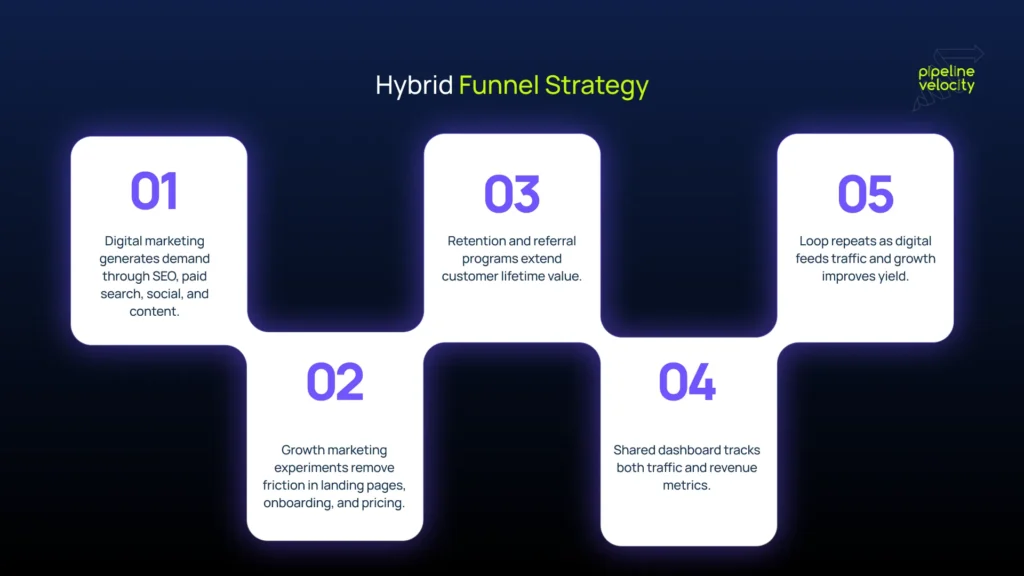
A hybrid plan gives you the best of both worlds, so this section lays out how to build one in clear steps. Start with a quarterly revenue model that maps targets to traffic and conversion by stage. Set budgets across SEO, paid media, content and lifecycle, then reserve a test fund for growth experiments. Define your cadence for creative refresh, landing page testing and onboarding improvements. Assign clear owners for channel execution and for cross-functional experiments that touch product or pricing. Review results every two weeks and shift resources to the highest ROI lever without delay.
Benchmark demand and seasonality with objective market data so forecasts stay grounded in reality.
Design for scalability so wins hold when traffic and spend double. Build systems that keep performance steady as campaigns expand across regions, segments and languages.
How marketing teams can align tactics across the funnel
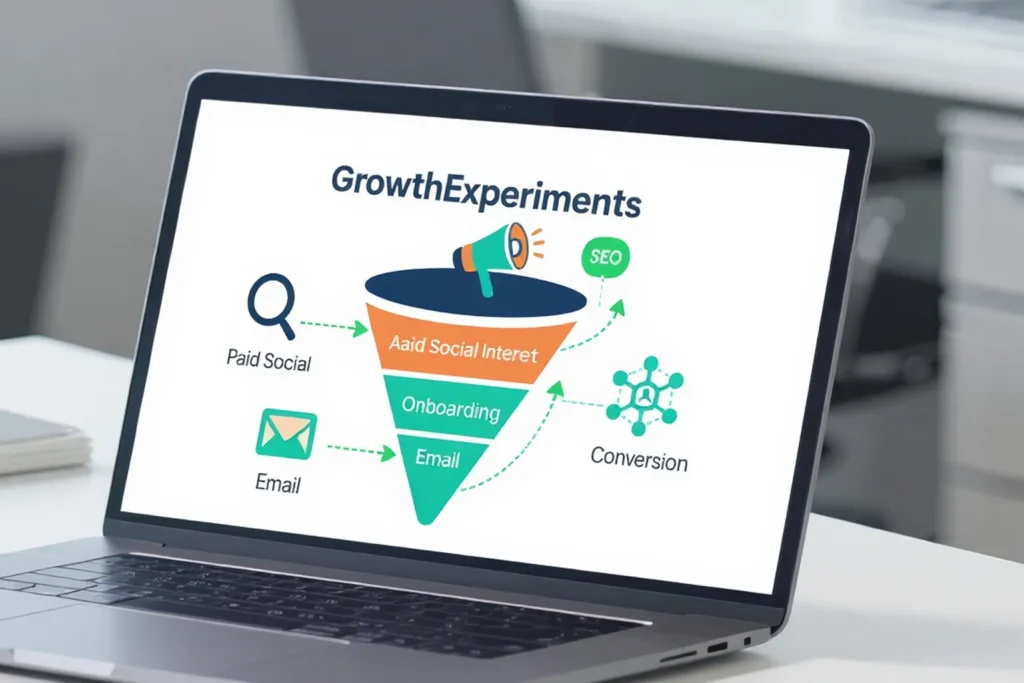
Alignment keeps teams fast and focused, so this section covers practical ways to stay in sync. Share one ICP, one message house and one set of stage definitions so handoffs stay clean. Use the same UTM structure and naming rules so reports match across tools. Plan quarterly themes that tie content, offers and product milestones into a single story. Keep a shared backlog for tests and campaigns, then vote on impact and effort to rank items. Celebrate wins together so people keep sharing ideas instead of guarding credit.
Examples of integrated campaigns that fuel long-term growth
Examples make alignment concrete, so this section offers plays you can run with your team. Launch a research-backed report that anchors SEO, supports PR and feeds paid social with snackable charts. Pair it with a calculator landing page and an in-product prompt that helps users apply the findings. Run a webinar series that addresses buyer objections and clip it into short videos for retargeting. Send a follow-up email sequence with templates and a limited-time upgrade that ties to the topic. Track influenced revenue and repeat for the next theme so momentum keeps building.
Promote each webinar with short teasers across social and paid, then share the deck and transcript as a content upgrade that nurtures registrants toward a clear next step.
Pipeline Velocity: Helping You Pick the Right Approach
You want a partner who can advise, build and measure without bias, so this section explains how Pipeline Velocity helps. Our teams run growth marketing sprints that diagnose funnel leaks, design experiments and instrument tracking. We also deliver digital marketing programs that scale SEO, paid search and paid social with creative that fits your brand. We help you pick the right starting point based on goals, budgets and time to impact. We then build a hybrid roadmap so channel execution and growth experiments work in one loop. If you want help choosing the next high-ROI move, talk with Pipeline Velocity and get a plan built around your targets.
We also help you evaluate and manage vendors so your stack, spend and talent pull in the same direction without waste.
At Pipeline Velocity, we help you scale with the right mix of services. If organic authority is the gap, our SEO Services and integrated PPC + SEO plans build durable visibility. If paid performance needs a lift, our PPC Management programs tune targeting, bids and creative for lower CAC. When social must drive sales, our Social Media Marketing team pairs content with conversion paths that sales can close.
In summary…, final thoughts
This section distills the article into actionable takeaways so you can act with confidence today.
- Growth marketing owns the full journey and optimizes activation, retention and expansion.
- Use growth when conversion, payback or churn block revenue goals.
- Prioritize experiments that fix the biggest funnel leaks first.
- Digital marketing scales awareness and demand across search, social and email.
- Use digital when reach, rankings or creative volume block pipeline.
- Track CPA, ROAS and pipeline influenced to fund the winners.
- The strongest results come from a hybrid plan with shared goals and dashboards.
- Let digital scale what growth proves.
- Let growth refine what digital discovers.
Tie your choice to your current bottleneck, then integrate both as you scale. Keep one revenue model, one backlog and one reporting language so your team moves fast and spends wisely.
FAQs
What is the main difference between growth marketing and digital marketing?
Growth marketing drives full-funnel revenue by optimizing product experience, pricing and lifecycle, while digital marketing focuses on channels that build awareness and demand. Growth uses experiments to raise activation, retention and expansion. Digital uses SEO, paid media, social and email to reach and convert audiences. Both matter, but they solve different problems.
Which is better for customer acquisition, growth marketing or digital marketing?
Digital marketing often wins first-touch acquisition because it controls search, social and paid traffic. Growth marketing improves acquisition efficiency by lifting conversion on landing pages, trials and onboarding. When you combine them, you capture more demand at lower cost. Most teams see the best acquisition numbers when digital feeds traffic and growth fixes friction.
Can growth marketing strategies replace traditional digital marketing services?
No, you still need channels to reach people at scale. Growth strategies raise the yield from that traffic by improving experience and messaging. Digital services like SEO, paid search and content keep the funnel full. Replace either and results drop. Run both with shared goals and you get compounding gains.
How does a growth marketing service improve customer retention?
Growth services improve retention by helping users reach value faster, then reminding them of that value over time. Teams add in-product education, lifecycle emails and habit cues that keep usage high. They fix confusing steps in onboarding and create paths to expand into higher tiers. They also test pricing and packaging that match how customers see value. These changes raise lifetime value and lower churn.
Should small businesses hire a growth marketing agency or a digital marketing agency?
Pick based on your bottleneck. If you lack traffic and brand awareness, a digital marketing agency gives faster wins. If you get visitors but few sales or repeat purchases, a growth marketing agency likely pays off sooner. Many small businesses start with digital for demand, then add growth to scale revenue without raising spend. If budget allows, pick a partner that can run both so you avoid siloed plans.



